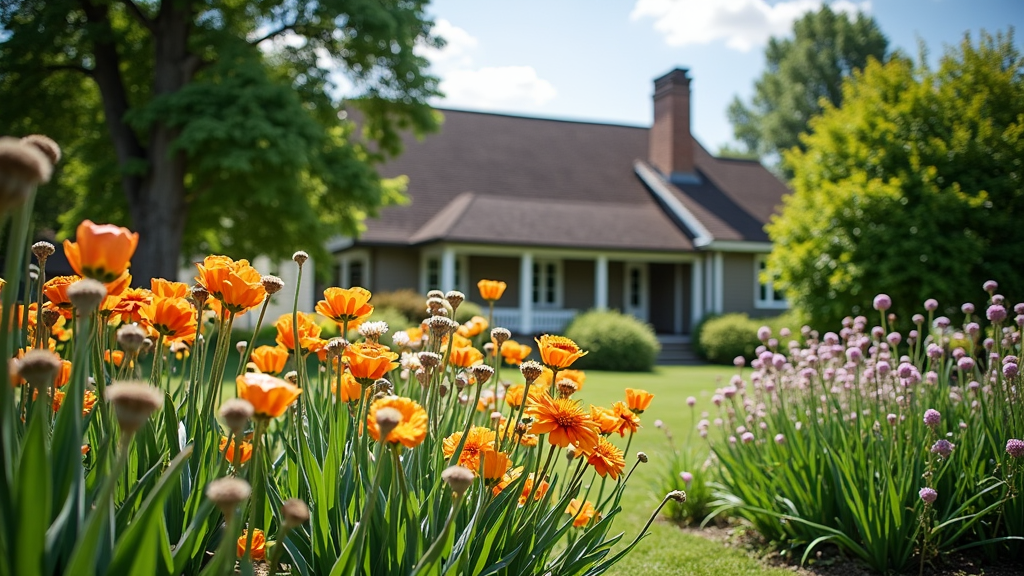Introduction
Color is one of the most significant aspects of landscape design, influencing not only aesthetics but also the emotional responses we have to various spaces. The vibrant hues of nature can either create a tranquil retreat or a lively gathering spot, depending on how they are utilized. In North Carolina, where lush greenery meets stunning blooms, understanding color theory in landscape design can dramatically elevate your outdoor space. This article aims to explore how to use color theory in your North Carolina landscape design, ensuring that you create an inviting and harmonious environment.
Understanding Color Theory in Landscape Design
What is Color Theory?
Color theory is a set of principles used to understand how colors interact with each other and how they affect our emotions. In the realm of landscape design, it’s vital because it helps designers select palettes that complement the natural surroundings while conveying specific moods.

Why is Color Important in Landscape Design?
Color serves several purposes in landscape design:
- Emotional Impact: Colors can evoke feelings; warm colors like reds and oranges can energize a space, while cool colors such as blues and greens provide calm. Visual Hierarchy: Utilizing color can help guide the eye through the landscape, highlighting focal points or creating pathways. Seasonal Variation: Different plants bloom at various times throughout the year. Understanding color theory allows for year-round visual interest.
The Basics of Color Theory: The Color Wheel
The foundation of color theory lies within the color wheel. It consists of primary colors (red, blue, yellow), secondary colors (green, orange, purple), and tertiary colors (the mix of primary and secondary).
Primary Colors
- Red Blue Yellow
Secondary Colors
- Green (from blue + yellow) Orange (from red + yellow) Purple (from red + blue)
Tertiary Colors
These are combinations of primary and secondary colors, such as red-orange or blue-green.
Color Harmony in Landscape Design
When considering color combinations for your landscape design in North Carolina, it’s crucial to explore harmony:
- Complementary Colors: These are opposite each other on the color wheel (e.g., blue and orange) and create striking contrasts. Analogous Colors: These sit next to each other on the wheel (e.g., blue, blue-green, green) and offer a more cohesive look. Triadic Colors: These form a triangle on the wheel (e.g., red, yellow, blue) providing balanced contrast.
How to Use Color Theory in Your North Carolina Landscape Design
Incorporating color theory into your landscaping project involves thoughtful planning and understanding the local climate. Here’s how you can effectively apply these concepts:
1. Assess Your Space
Before diving into plant selection or hardscape features, take a step back and assess your yard's natural characteristics:
- What kind of light does different areas receive? Are there existing structures or plants that you want to highlight or downplay?
2. Determine Your Goals
What do you want your landscape to convey? Relaxation? Energy? A sense of unity with nature? Define this upfront as it will guide your color choices.
3. Choose a Color Palette
Once you've assessed your space and defined your goals:
- Opt for 3–5 main colors based on your desired mood.
Example Palettes: | Mood | Color Choices | |--------------|-----------------------------------| | Tranquil | Soft blues, greens | | Energetic | Bright yellows, oranges | | Harmonious | Earthy browns mixed with greens |
4. Consider Seasonal Changes
North Carolina experiences four seasons; hence it's essential to incorporate plants that will provide year-round interest:
- Spring blooms: Dogwoods (white/pink) Summer foliage: Ornamental grasses Fall colors: Maples turning vibrant red/orange Winter textures: Evergreens for structure
5. Create Focal Points with Bold Colors
A bold splash of color can serve as an eye-catching focal point within a garden:
- Consider using bright annuals like zinnias or dahlias surrounded by lush greenery for contrast.
Applying Color Theory in Various Elements of Landscape Design
6. Plants as Living Canvas
Plants are undoubtedly at the forefront when employing color theory in landscape design North Carolina-style:
- Flowering Plants
Choose flowers according to their blooming seasons and hues that work together harmoniously.
- Foliage Plants
Evergreen shrubs can add depth with their rich greens even when flowers aren’t blooming.
7. Hardscape Elements
Your choice of materials—stone patios versus wooden decks—can significantly impact the overall palette:
- Pavers
Select pavers that complement your chosen plant life.
- Furniture
Use outdoor furniture that aligns with your desired atmosphere—bright cushions for vibrancy or neutral tones for subtlety.
8. Water Features
Water features like ponds or fountains can introduce reflective qualities:
- Reflections
Consider how surrounding plants will mirror off water surfaces during different times of day.
9. Lighting Considerations
Lighting plays a key role in showcasing colors after sunset:

- Pathway Lights
Utilize soft lighting along pathways to enhance nighttime charm without overshadowing plant hues.
- Spotlighting Key Areas
Highlight focal plants with upward lighting techniques.
Practical Tips for Implementing Color Theory
10. Start Small
If you're new to using color theory in landscape design: Begin with small flower beds or container gardens before tackling larger spaces.
11. Observe Nature
Take walks around parks or botanical gardens—notice what pleases you about certain combinations!
12. Collaborate with Professionals
Consulting an experienced landscape designer familiar with local flora can save time—and help avoid costly mistakes!
FAQs About Using Color Theory in Landscape Design
1. How do I choose complementary colors for my garden?
Start by identifying one dominant hue from existing plants or hardscapes; then find its counterpart directly across from it on the color wheel.
2. What is seasonal planting?
Seasonal planting involves selecting flora based on their blooming cycles so that there are always colorful elements present throughout the year.
3. Can I mix different styles using color theory?
Absolutely! Blending modern clean lines with traditional cottage garden styles benefits greatly from cohesive palettes derived from color theory principles.
4. Are there any specific plants suited for North Carolina landscapes?
Yes! Native plants such as azaleas thrive https://postheaven.net/vestergunt/landscaping-challenges-unique-to-the-terrain-of-stokesdale-nc here; they come in many hues—from soft pinks to vivid reds—which align beautifully within various palettes!
5. What role does texture play alongside color?
While colors evoke emotion; textures add depth! Combining smooth leaves with rough bark creates visual interest against flat backgrounds resulting from paint strokes!
6. Is hiring a professional worth it when designing my landscaping plans?
If navigating complex concepts seems daunting—working alongside professionals ensures that choices align well within established frameworks while enhancing personal preferences!
Conclusion
Understanding how to use color theory in your North Carolina landscape design opens up endless possibilities—from creating serene outdoor retreats filled with tranquility through soft blues and greens to lively gardens bursting with energy from vibrant reds and yellows! By thoughtfully assessing your space and choosing complementary palettes tailored specifically towards seasonal variety—you’ll have every reason under heaven not just enjoy visually pleasing spaces but also cultivate environments rich emotionally too! So get out there—grab those brushes—and let nature inspire every stroke along life’s canvas!